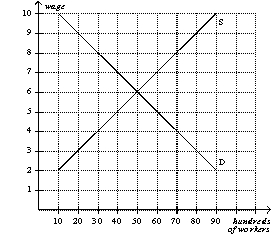B) False
Correct Answer

verified
Correct Answer
verified
Multiple Choice
Meredith is looking for work as a computer programmer.Although her prospects are good,she hasn't yet taken a job.Julie is looking for work in a steel mill.Every time she shows up for an interview,there are more people looking for work than their are openings.Someone waiting in line with her tells her it has been that way for a long time.
A) Meredith and Julie are both frictionally unemployed.
B) Meredith and Julie are both structurally unemployed.
C) Meredith is frictionally unemployed,and Julie is structurally unemployed.
D) Meredith is structurally unemployed,and Julie is frictionally unemployed.
F) All of the above
Correct Answer

verified
Correct Answer
verified
Multiple Choice
Table 20-4
 -Refer to Table 20-4.What is the U-3 measure of labor underutilization?
-Refer to Table 20-4.What is the U-3 measure of labor underutilization?
A) 4.7 percent
B) 6.2 percent
C) 7.0 percent
D) 10.9 percent
F) C) and D)
Correct Answer

verified
Correct Answer
verified
Multiple Choice
Figure 20-1  -Refer to Figure 20-1.If the government imposes a minimum wage of $8,then unemployment will increase by
-Refer to Figure 20-1.If the government imposes a minimum wage of $8,then unemployment will increase by
A) 0 workers.
B) 2000 workers.
C) 4000 workers.
D) 7000 workers.
F) B) and C)
Correct Answer

verified
Correct Answer
verified
Multiple Choice
Job search
A) and firms paying wages above equilibrium to improve worker health both create frictional unemployment.
B) creates frictional unemployment,while firms paying wages above equilibrium to improve worker health creates structural unemployment.
C) creates structural unemployment,while firms paying wages above equilibrium to improve worker health creates frictional unemployment.
D) and firms paying wages above equilibrium to improve worker health both create structural unemployment.
F) A) and D)
Correct Answer

verified
Correct Answer
verified
Multiple Choice
Figure 20-1  -Refer to Figure 20-1.If the government imposes a minimum wage of $4,then employment will decrease by
-Refer to Figure 20-1.If the government imposes a minimum wage of $4,then employment will decrease by
A) 0 workers.
B) 2000 workers.
C) 3000 workers.
D) 4000 workers.
F) None of the above
Correct Answer

verified
Correct Answer
verified
True/False
Every week,the Bureau of Labor Statistics produces data on unemployment.
B) False
Correct Answer

verified
Correct Answer
verified
Multiple Choice
Of the following groups,who is eligible for unemployment insurance benefits?
A) the unemployed who quit their jobs
B) the unemployed who were laid off because their previous employers no longer needed their skills
C) the unemployed who were fired for cause
D) the unemployed who just entered the labor force
F) A) and D)
Correct Answer

verified
Correct Answer
verified
True/False
Policies that reduce the time it takes unemployed workers to find new jobs can reduce the economy's natural rate of unemployment.
B) False
Correct Answer

verified
Correct Answer
verified
True/False
The Bureau of Labor Statistics' household survey and establishment survey both yield information about unemployment.
B) False
Correct Answer

verified
Correct Answer
verified
True/False
The unemployment rate equals the percentage of the adult population that is unemployed.
B) False
Correct Answer

verified
Correct Answer
verified
Multiple Choice
The theory of efficiency wages provides a possible explanation as to why
A) workers form unions.
B) firms should try to reduce surpluses of labor.
C) firms may be inclined to keep their workers' wages above the equilibrium level.
D) firms may be inclined to keep their workers' wages below the equilibrium level.
F) All of the above
Correct Answer

verified
Correct Answer
verified
Multiple Choice
Figure 20-1  -Refer to Figure 20-1.If the government imposes a minimum wage of $4,then unemployment will increase by
-Refer to Figure 20-1.If the government imposes a minimum wage of $4,then unemployment will increase by
A) 0 workers.
B) 2000 workers.
C) 4000 workers.
D) 5000 workers.
F) All of the above
Correct Answer

verified
Correct Answer
verified
True/False
Sectoral shifts contribute to structural unemployment.
B) False
Correct Answer

verified
Correct Answer
verified
True/False
Someone who has a job but is absent from work because she is on vacation is counted as employed.
B) False
Correct Answer

verified
Correct Answer
verified
Multiple Choice
Unions
A) raise the wages of unionized workers and raise unemployment.
B) raise the wages of unionized workers and reduce unemployment.
C) reduce the wages of unionized workers and raise unemployment.
D) reduce the wages of unionized workers and reduce unemployment.
F) None of the above
Correct Answer

verified
Correct Answer
verified
Multiple Choice
The Wagner Act of 1935
A) prevents unions from acting as cartels.
B) allows workers joining a unionized firm to choose not to join the union.
C) prevents employers from interfering when workers try to organize a union.
D) prevents firms from hiring permanent replacements for workers who are on strike.
F) A) and D)
Correct Answer

verified
Correct Answer
verified
Multiple Choice
The Bureau of Labor Statistics reported in 2005 that there were 50.40 million people over age 25 whose highest level of education was some college or an associate degree,33.86 million of whom were employed and 1.27 million of whom were unemployed.What were the labor-force participation rate and the unemployment rate for this group?
A) 69.7% and 2.5%
B) 69.7% and 3.6%
C) 67.2% and 2.5%
D) 67.2% and 3.6%
F) None of the above
Correct Answer

verified
Correct Answer
verified
True/False
If all workers and all jobs were the same such that all workers were equally well suited for all jobs,then there would be no frictional unemployment.
B) False
Correct Answer

verified
Correct Answer
verified
Multiple Choice
Sample Population
 -Refer to Sample Population.How many in the sample are unemployed?
-Refer to Sample Population.How many in the sample are unemployed?
A) 5
B) 4
C) 3
D) None of the above is correct.
F) A) and B)
Correct Answer

verified
Correct Answer
verified
Showing 121 - 140 of 572
Related Exams